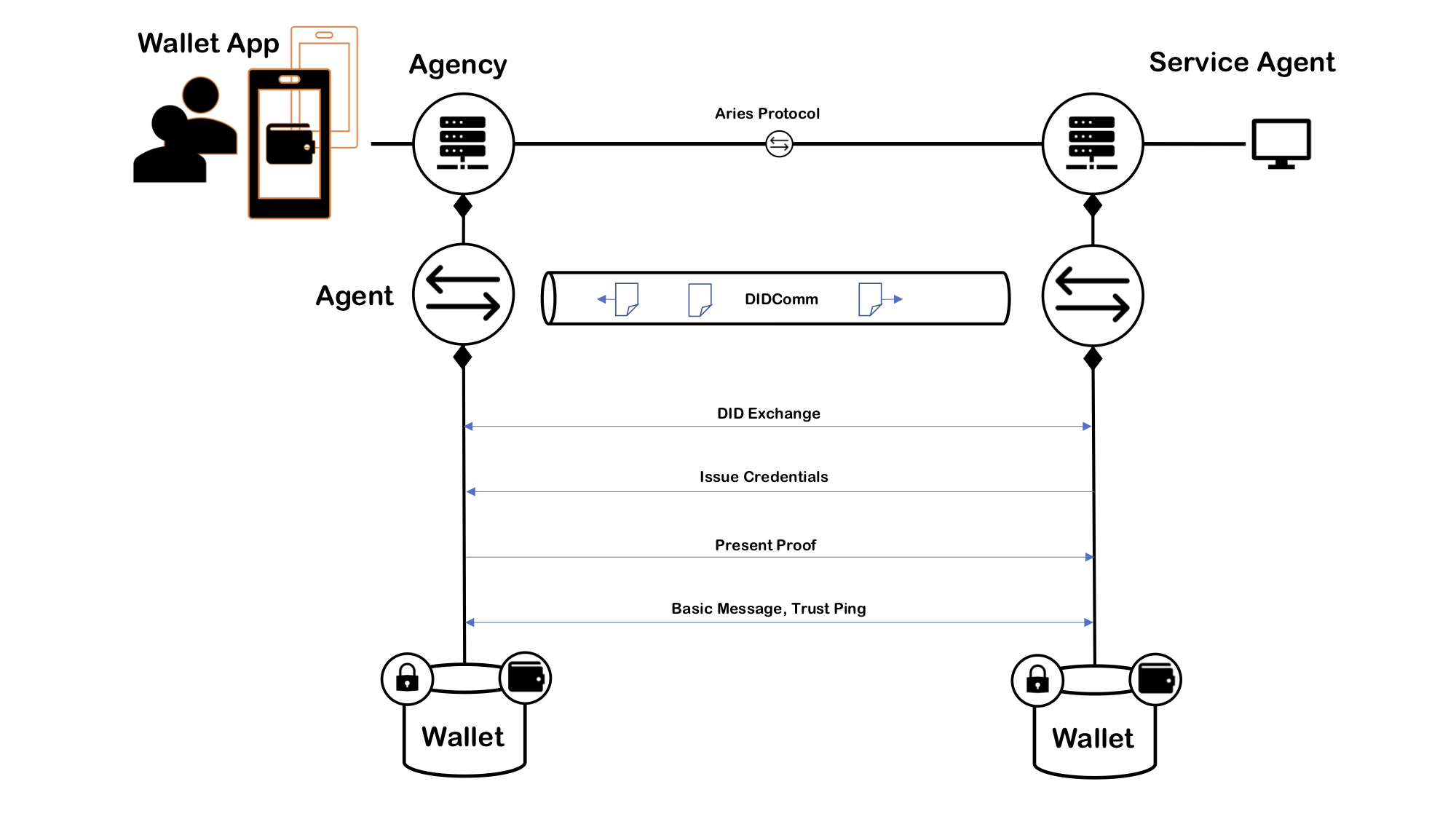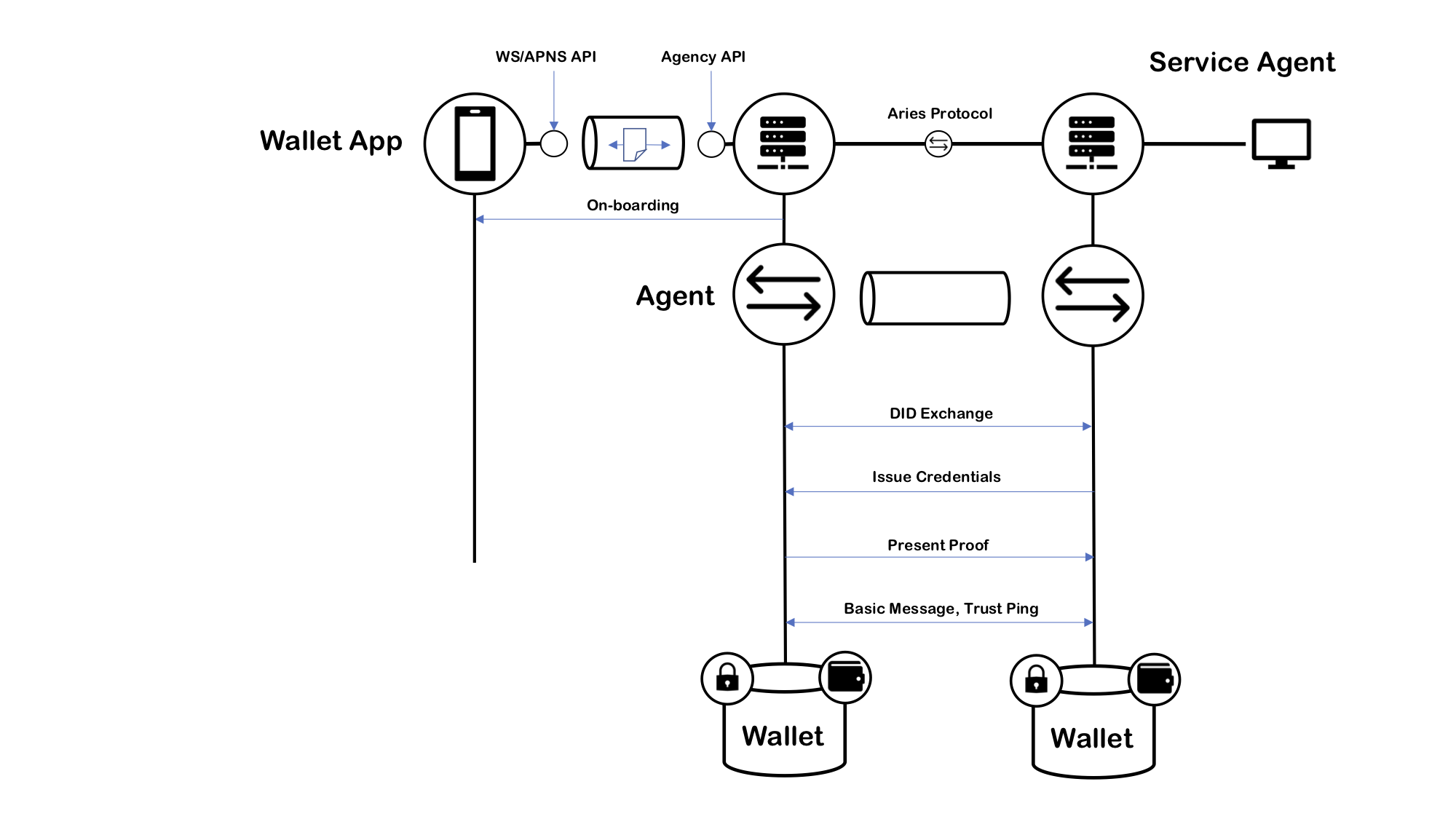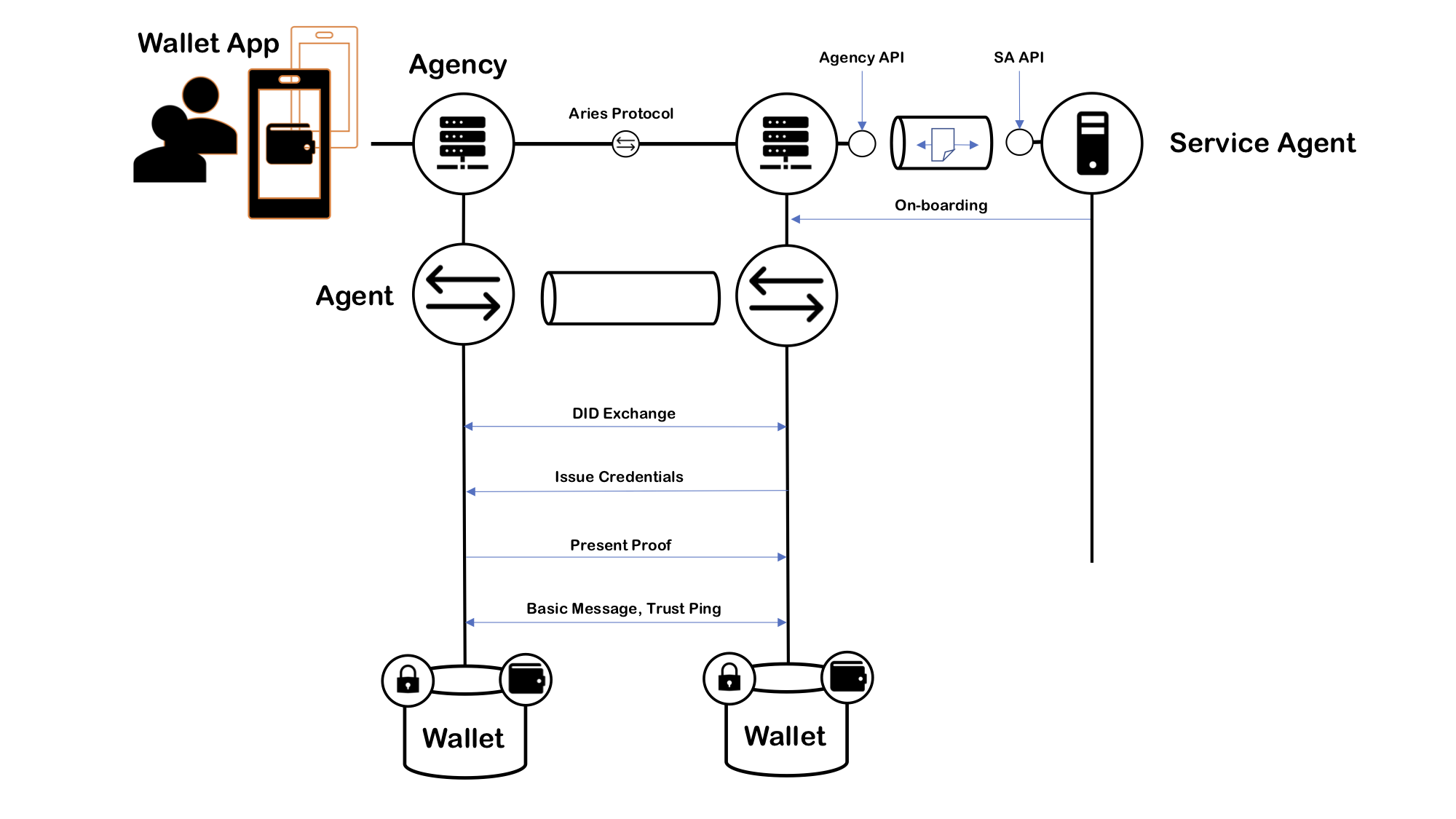findy-agent



About findy-agent
Findy agency is a high-performing, multi-tenant identity agency for Aries
protocols. It offers a way to allocate Cloud Agents and control them thru gRPC
interfaces. You can think it like a database service, or SMTP service, but it's
a SSI service. With help of it you can run your DID agents where ever you have
installed the Findy Agency. Preferred installation place for it is a host with
static internet presence.
The root of trust for each CAs is in FIDO2 authenticators. WebAuth server
on-boards new agents and JWT is used for the authorization.
You can use Findy Agency roughly for these purposes:
-
As a multi-tenant service for allocating multiple Cloud Agents which
implement Aries agent-to-agent protocols
and offer SSI interoperability.
-
As a CLI tool to setup an agency and maintain it.
You can create steward DID and wallet; or you can import steward from
existing wallet. For command line use it offers all the same features as
indy cli.
-
As a high-performing SDK to implement all types SSI Agents like holders,
issuers and verifiers with any programming language you chose which is
supported by gRPC.
The Findy Agency is very fast and it is extremely resource efficient; and of
course it's Aries compatible.
Get Started
Findy Agency is a collection of services (Core - this service, WebAuthn,
Findy Vault and Web Wallet) that provide full SSI agency along with a web wallet for individuals. To start experimenting with Findy Agency we recommend you to start with the documentation and set up the agency to your localhost environment.
You can communicate with your agency by gRPC and it offers
a CLI tool as well. More documentation for testing with CLI can be found here.
Development
Ubuntu 20.04 is preferred development environment but macOS is also an option.
Please make sure that Go and git are both installed and working properly.
Note! Go modules must be on.
Linux and Ubuntu
We recommend that you first install findy-wrapper-go and follow its guides to
setup environment and especially install libindy.
-
Install libindy-dev.
-
Clone findy-agent (this repo)
-
Install needed Go packages: make deps.
-
Install the command line application: make install
-
Verify the installation: findy-agent -version
It should output similar to:
findy-agent version 0.xx.xx
Because indy SDK won't offer proper distribution for OSX, we have written a
helper Bash script to perform installation. Follow these steps in
findy-wrapper-go repo:
- Install Homebrew if it isn't already on your machine.
- Clone the repo:
git clone https://github.com/findy-network/findy-wrapper-go
- Go to directory
findy-wrapper-go/scripts/mac-libindy:
$ cd scripts/mac-libindy
- Execute the installation script.
$ ./install.sh
Or, if you want to change the default installation location, enter it as
a first argument for the script.
$ ./install.sh /my/own/location
- Follow the instructions of the
install.sh i.e. source the env.sh which
is generated to installation directory and is in your clipboard after successful
installation.
$ source /usr/local/opt/libindy/env.sh
- Run the tests to see everything is OK with Go wrapper and
libindy:
make test
- Then follow instructions from previous section Linux and Ubuntu from step
2 to complete
findy-agent repo's setup.
The problem solving tip: source env.sh in your dev session.
Run The Agency
As said earlier the most convenient way to run Findy Agency is from docker
container. Still, it's at least as easy to run from standalone binary if you
have proper environment for it to run i.e. libindy installed.
The following chapters describe how to start an agency with different type of
ledgers. Before running the agency you must create steward DID and wallet for
your test network.
Create Test Steward
To create new steward DID and wallet run the following commands:
$ cd scripts/test
$ findy-agent ledger steward create --config create-steward-to-mem-ledger.yaml
The create-steward-to-mem-ledger.yaml includes following data.
pool-name: "FINDY_MEM_LEDGER"
seed: "000000000000000000000000Steward1"
wallet-name: "sovrin_steward_wallet"
wallet-key: "4Vwsj6Qcczmhk2Ak7H5GGvFE1cQCdRtWfW4jchahNUoE"
You can edit it for your purpose. Please note to use same wallet-key in it and
the start script like mem-server script in the same directory.
Run with Memory Ledger
Memory ledger is available as long as the agency is running but after that data
is lost. It's very good for tests and short demos.
cd scripts/test./mem-server
Run with File Ledger
File ledger is a test ledger where ledger data is persistently stored into a
JSON file. It's convenient for cases where you don't want to run all ledger
nodes on your machine like development.
cd scripts/test./file-server
Run with Real Ledger
-
Install and start ledger
-
Create a ledger pool with the name von
findy-agent ledger pool create --name="von" --genesis-txn-file="genesis.file"
-
Go to scripts/test directory: cd scripts/test
-
Run the agency tests: ./von-network-server
-
Connect to agency with your client or test it with the agency's ping command.
Please see the helper scripts in the scripts directory.
All of that can be done with the make scratch as well if the predefined ledger
and steward wallet names are OK. The previous steps were for educational
purposes. If you want to start the agency fast e.g., on OSX, the Makefile
approach is preferable. Please see the scrips in the tools directory.
Agent On-boarding
Findy-agent serves all types of cloud agents (CA) like holder, issuer and
verifier. Cloud agents must be allocated before they can be used. CA
allocation is called on-boarding. In most cases it's done thru WebAuthn server
like findy-agent-auth but you can allocate them directly from the agency.
Currently only findy-agent-auth on-boards agents to Findy Agency. Since gRPC
API you should run both Findy Agency and Findy WebAuthn Service where later is
only used for authentication: register and login. The JWT token is used to
access allocated CA. Please see more [information].
Agency Network
findy-agent is a multi-tenant identity agency that is capable serve thousands of
agents with one installation, and which can scale horizontally.
The following diagram shows all the components of a typical DID/SSI-based
identity network. The server rack icon illustrates an agency. There are three in
the picture, but typically there can be as many as needed, and agencies can run
in a cluster for horizontal scalability.

In the middle of the picture is the indy ledger. Depending on the installation
and the type of the network, it can be a public ledger or just a development
ledger. All the communication to the ledger goes through the agencies. Also, all
the Aries agent-to-agent communication goes from agency to agency, as you can
see in the following drawing.

The application logic is inside the agent controllers. The next image
illustrates when a mobile controller communicates findy-agent, it calls the
agency's CA API and receives notifications.

Likewise, when a SA communicates with an agency, it calls the agency's CA API
and receives notifications and questions from the agency.
The image below shows how CAs communicate with Aries.

Command-line Interface
Findy agency offers an extensive set of commands by itself, and other command
set exists in findy-agent-cli. In addition to that, many other tasks have to
be taken care of before a full agency setup can work. The following use case
diagram shows most of the tasks and uses system boundaries to illustrate which
of them are directly operable by findy-agent or findy-agent.

As the diagram shows the prerequisites to start the agency are:
- A steward wallet is available, or you have seed to create steward wallet by
your self.
- You have to set up a server environment, like volumes for wallets, and
databases.
During the agency run, you can monitor its logs. Between the starts, you can
reset the all cloud agent allocations, or you can edit the register JSON. Note,
that you cannot add new allocations only by editing the register JSON. The whole
handshake procedure must be performed.
When an agency is running, you can operate with it findy-agent executable when
you use it as a client mode. The following use case diagram shows the essential
commands after the agency started.

The use case diagram is a summary of the creation commands available. With these
commands, you can create all that is needed in the identity network from the
command line.

Agency Architecture
Findy agency is a service that implements an Aries compatible identity agents.
What makes it an agency is that it's multi-tenant. It can easily serve thousands of edge
agents with one installation and with modest hardware.
Each CA controller gets a corresponding cloud agent as its service. The following
deployment diagram illustrates the main components of the typical system where
findy-agent is installed on a single node, and a wallet application is running
as PWA in the browser. The picture includes an external agent that is running on
another node (grey).

As the diagram shows, the main wallet of each agent is on the server, our we
could say it is in the cloud. That simplifies things a lot. We can have cloud
backups, recovery, and most importantly, it makes it possible to 24/7 presence
in the cloud for each agent.
The issuer server could run on the same node as the agency, but the most common
case is where it runs on its own. Typical SA includes application logic, and the
issuing credential is a small part. The API between SA and the agency is quite
straightforward. The API runs on DIDComm similarly to mobile agents.
Aries Protocol State Machine
The following sequence diagram shows an example of how two cloud agents send
messages to each other and save them to Bolt DB (Go implementation of LMBD). The
diagram shows the "transactional" implementation of HTTP-based message transfer.
Receiving the message is done by first saving the incoming message to the
database and after that returning OK. If the receiver cannot save the incoming
message, it returns an error code.

The next UML diagram implements the connection protocol as a finite state
machine, which has two top-level states: Waiting Start Cmd/Msg, and
ConnectionProtocolRunning. The protocol waits for either a command or a message.
The command can be an InvitationCmd, which means that we have received an
invitation. In the current system, invitations are coming from other channels,
and they are not protocol-messages (out-bound). The invitation includes
connection information to an agent like an endpoint and its public key. The
agent who receives the InvitationCmd sends a connection request message
(ConnReq) to the receiving agent and starts to wait for a connection response
message (ConnResp). As the state machine shows, the receiving agent sends the
connection response back and finalizes its state machine. The agent who started
the connection protocol receives the connection response message and finalizes
its state machine.

The previously seen ConnectionProtocolRunning state divides two separate state
machines. The left sub-state machine is on when the agent is an inviter, and the
right-sided is on when the agent is an invitee. This same basic structure is in
all of the Aries protocol state machines. One of the agents initiates the
protocol, which gives the roles for them: inviter/invitee, issuer/holder,
prover/verifier. However, most of the Aries protocols are more complicated
because both of the roles can initiate the protocol, and depending on the
message it sends, the role it gets for the protocol.

The issuing protocol state machine is waiting for a command to initiate the
protocol or incoming message to connect already started protocol (Waiting Start
Cmd/Msg -state). If an agent is in an issuer's role, it can start the protocol
by sending a credential offer message (CredOffer). It can do that by sending
CredOfferCmd to the protocol processor, as we can see in the state machine
diagram. Similarly, when an agent is in a holder's role, it can start the
protocol by sending a credential-propose message (CredProp), and it can do that
by sending CredProposeCmd to the protocol processor. Naturally, when an agent
receives either an offer or a propose, it responses accordingly. Receiving a
credential offer puts an agent to a holder's role, and receiving a credential
propose puts an agent to an issuer's role. Now we should understand how we have
four related ways to initiate the protocol state machine for an issuing protocol
(state transition from Waiting Start Cmd/Msg -state to
IssuingProtocolRunning-state). The rest of the protocol is quite clear and easy
to understand from the state machine diagram.
Upcoming Features
- Tests for fail cases. WIP
- Interoperability testing with Aries testing harness.
- Indy wallet implementation with storage plug-in like PostgreSQL. Done: we
have wallet pool.
- Crypto implementations for different server types, AWS Nitro, ...
- Backup system for current docker volumes.
- The PSM runner for restarts and non-delivery messages and cleanup old
ones. Partially done, we have data pump and archiving now.
- Haven't been able to test with stable ledger.
- Check if we have received the message already.
- Check incoming order of the messages, same as declared in the PSM.
- libindy under pressure, wallet handles, etc. Done: wallet pool, more tests
needed
- API for browsing connections, credentials etc. Done: we have
vault
- PSM archive logic, dedicated storage for persistent client data (see the
PSM runner).
- Credential revocation, if wanted to use (check upcoming anoncreds 2.0)
- Skipping DID-writes to ledger for individuals: moving to full
peer did.
- Real
peer did implementation. (Static did:peer)
- Agent permissions. Separation of individuals and services in on-boarding
-> e.g. no credential issuing for individuals (maybe Agency types).
 Documentation
¶
Documentation
¶
 Directories
¶
Directories
¶



